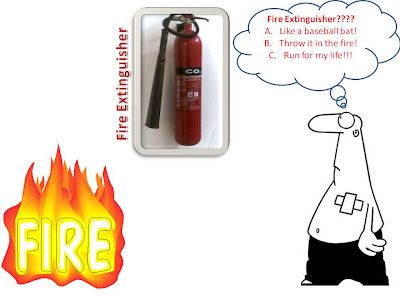The Fire Extinguisher, most of us of course have seen this usually red or blue painted cylinder somewhere but unfortunately only a few know how to use it or even has the courage to use it in times of emergency.
But this little fellow could not only save you but everybody and everything you have when the circumstances are still right.
In todays homes a fire extinguisher is a must, of course a little tag price but for the investment it can save you its worth the price. Buying one won't do much either if nobody or just a few knows how to use it and when to use it.
Lets us put this straight first, ONLY use the proper Fire extinguisher for small fires which it can still manage, this precaution is for your own safety so please reconsider. Let's leave the real firefighting to the professionals shall we?
When is small fires still manageable?
A good question really but in order not to gamble your life and to be safe its when the fire just started and can still be confined to a small area where your fire extinguisher range and capacity is still in excess and in folds. whew too technical... okay its when the fire just starts and when you can still run for safety and also everybody, feeling much better?
Who should learn how to use Fire Extinguishers?
Practically everybody! it is ideal for the first person to spot the fire to immediately respond to extinguish it at the earliest possible time. This is the win win scenario, so everyone at home, in work places, or in school need to know how to use and handle small fires.
Don't Try other Methods Use the extinguisher Soonest...
Sometimes our reflex are quick and we try to contain fire with whatever we got at hand but often times this action could actually worsen the scenario and spread the fire...
The best way is to immediately grab the fire extinguisher and use it the smaller the fire still the better chance for you to clear it. So heroics is not an option and there's no camera tricks in real fires so don't waste time in blowing the fire because your just feeding it unless your blowing a candle for your birthday party? :)
What's in the fire extinguisher?
There are different types of fire extinguisher intended for different types of fire. They vary from the materials they used and for the type of fire it can pout off.
Fire Extinguishant Materials
•Water - class A only - cools /removes heat
•Dry Chemical - class A, B, or C - interferes with chemical reaction
•Carbon Dioxide - class A, B, or C (usually C) - removes Oxygen /
smothers fire
•Metl-X - class D only - specialized dry chemical for metal fires
•Foam – Class B, holds down vapors
How to Use the Fire Extinguisher?
Remember this T-P-A-S-S
T-P-A-S-S System
•T – Twist Pin to break seal
•P – Pull Pin
•A – Aim at the base of the fire or leading edge
•S – Squeeze Handle (top of handle activates extinguisher)
•S – Sweep across base or leading edge of fire

Whalah...simple right? with presence of mind and no panic not only you can save lives but investments as well. Simple things matter with a quick judgement your hard earned things and even your loved ones will never be part of the ashes after a fire gone out of control but could have been controlled. Only if you knew how to use that thing hanging in a corner called the Fire Extinguisher.
And in a fire situation remember this also R-A-C-E
•R escue – rescue people in immediate danger.
•A lert – yell out “Fire”, pull fire alarm, dial emergency phone number.
•C lose – Close energy sources, all doors and windows.
•E xtinguish/Evacuate – Extinguish small fires, evacuate if necessary.
For inquisitive minds heres a few more you should know about fire extinguishers.

Fire Extinguisher Table

more interesting topics to be posted... :)
Previous posts links:


































